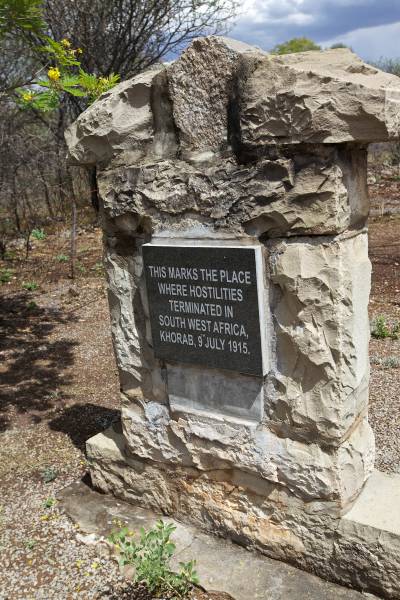|
Khorab Peace
Khorab, a farm oasis 2.6 km north of Otavi, Namibia, hosts a monument commemorating negotiations between South African and German troops fighting in World War I. These led to the surrender of around 4,000 German soldiers in what was known as the Treaty of Khorab. The monument was dedicated on September 28, 1973. On the South African side, the treaty was signed by Louis Botha, commander of South African forces and Prime Minister, and five of his officers, including Botha's Chief of Staff, Col. J.J. Colyer. On the German side, the signatories included Dr. Theodor Seitz, Governor of German South West Africa (DSWA); Col. Victor Franke, commander of German forces in the DSWA; Lt. Col. Heinrich von Bethe, commander of the DSWA police; and five junior officers. Seitz was assisted in negotiating by Hans Graf von Schwerin-Löwitz Hans Axel Tammo Graf von Schwerin-Löwitz (19 May 1847, Löwitz – 4 November 1918) was a German politician for German Conservative Party and officer. ... [...More Info...] [...Related Items...] OR: [Wikipedia] [Google] [Baidu] |
Namibia - Khorab Memorial At Kilometre 500 02
Namibia (, ), officially the Republic of Namibia, is a country in Southern Africa. Its western border is the Atlantic Ocean. It shares land borders with Zambia and Angola to the north, Botswana to the east and South Africa to the south and east. Although it does not border Zimbabwe, less than 200 metres (660 feet) of the Botswanan right bank of the Zambezi River separates the two countries. Namibia gained independence from South Africa on 21 March 1990, following the Namibian War of Independence. Its capital and largest city is Windhoek. Namibia is a member state of the United Nations (UN), the Southern African Development Community (SADC), the African Union (AU) and the Commonwealth of Nations. The driest country in sub-Saharan Africa, Namibia has been inhabited since pre-historic times by the San, Damara and Nama people. Around the 14th century, immigrating Bantu peoples arrived as part of the Bantu expansion. Since then, the Bantu groups, the largest being the Ovambo ... [...More Info...] [...Related Items...] OR: [Wikipedia] [Google] [Baidu] |
